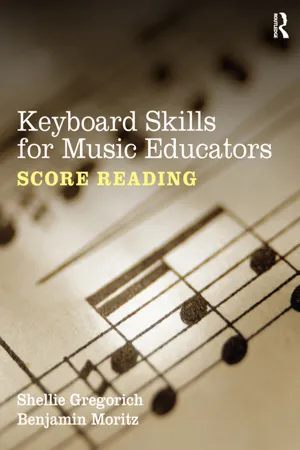
- 336 pages
- English
- ePUB (mobile friendly)
- Available on iOS & Android
Keyboard Skills for Music Educators: Score Reading
About this book
Keyboard Skills for Music Educators: Score Reading is the first textbook equip future educators with the ability to play from an open score at the keyboard. Score reading can be a daunting prospect for even the most accomplished pianist, but it is a skill required of all choral and instrumental music instructors. Although most music education curricula include requirements to achieve a certain level of proficiency in open score reading, standard textbooks contain very little material devoted to developing this skill.
This textbook provides a gradual and graded approach, progressing from two-part reading to four or more parts in a variety of clefs. Each chapter focuses on one grouping of voices and provides many musical examples from a broad sampling of choral and instrumental repertoire ranging from Renaissance to contemporary works.
Frequently asked questions
- Essential is ideal for learners and professionals who enjoy exploring a wide range of subjects. Access the Essential Library with 800,000+ trusted titles and best-sellers across business, personal growth, and the humanities. Includes unlimited reading time and Standard Read Aloud voice.
- Complete: Perfect for advanced learners and researchers needing full, unrestricted access. Unlock 1.4M+ books across hundreds of subjects, including academic and specialized titles. The Complete Plan also includes advanced features like Premium Read Aloud and Research Assistant.
Please note we cannot support devices running on iOS 13 and Android 7 or earlier. Learn more about using the app.
Information
Part 1
Two and Three Part Reading in Traditional Clefs
Chapter 1
Two Parts: Treble/Bass
1 Introduction






2 Sight-reading Exercises
Table of contents
- Cover
- Halftitle
- Title
- Copyright
- Contents
- Preface: The Unique Challenges of Reading Open Score
- Acknowledgements
- PART 1. Two and Three Part Reading in Traditional Clefs
- PART 2. Two and Three Part Reading including the Tenor
- PART 3. Four Part Reading
- PART 4. Instrumental Part Reading
- Appendix. Choral Warm-Up Exercises
- Index of Excerpts